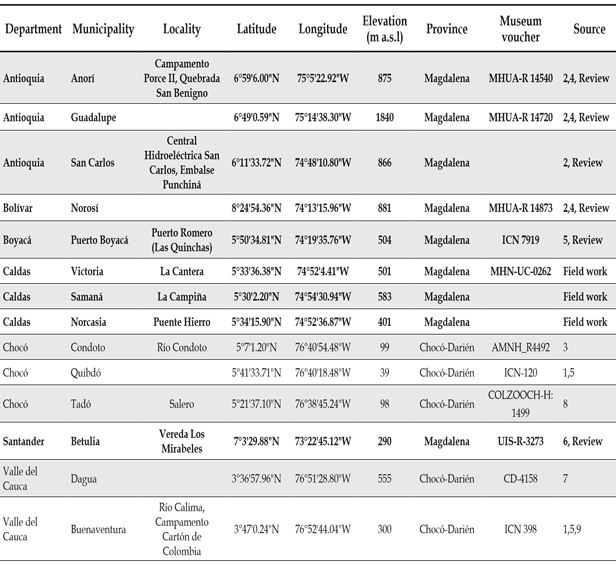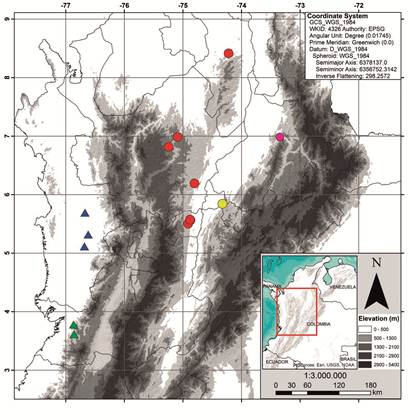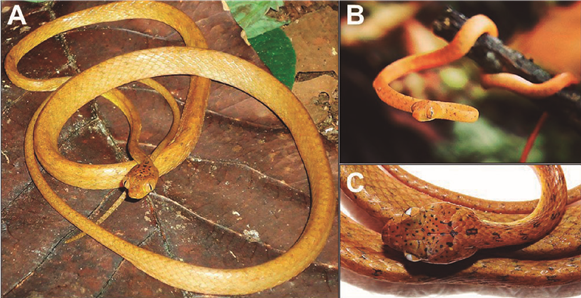Introduction
Accurate information on species distribution the status of threatened species (IUCN, 2012). and natural history is the basis for biodiversity With over 270 snake species, Colombia is one of management and conservation (González-Maya the richest countries in snake fauna in the world, et al., 2014), for it is a key attribute for assessing surpassed only by Mexico and Brazil (http://www.reptile-database.org, Lynch et al.,2014 ). However, knowledge about biological aspects such as diversity patterns, distribution, natural history, and conservation status of Colombian snakes is still incipient and poorly represented in scientific literature. Although herpetological collections from the late nineteenth and early twentieth centuries have provided a large collection of snakes from almost all Colombian eco-regions (Lynch et al., 2014), reviews have been made only on a few species (<10 %), generating major challenges in terms of snake conservation (Lynch, 2012, 2015).
The Neotropical Speckled Blunt-headed Tree Snake of the genus Imantodes (Linnaeus, 1758), are nocturnal and arboreal species. Eight nominal species of Imantodes are currently known. They are widely distributed from Central to South America (Myers, 1982; Torres-Carvajal et al., 2012; Medina-Rangel et al., 2018). These snakes have arboreal habits with morphological features adapted to this microhabitat, including thin bodies and enlarged heads with protuberant eyes, which differs significantly from the neck (Savage, 2002; Torres-Carvajal et al., 2012). There are seven species of Imantodes in Colombia, which are: I. cenchoa (Linnaeus, 1758); I. chocoensisTorresCarvajal et al. 2012; I. gemmistratus (Cope, 1861); I. guane Missassi & Prudente 2015; I. inornatus (Boulenger, 1896); I. lentiferus (Cope, 1894); I. phantasma Myers 1982 (Medina-Rangel et al., 2018). The genus Imantodes is distributed throughout the country, from sea level to 2300 m of elevation, but certain eco-regions are poorly represented with few published data, such as the Orinoco savannas and the Amazonian rainforest (see Rojas-Morales et al., 2014 for I. cenchoa), biogeographic provinces of Orinoquia, Guayana and Amazonia (sensuHernandez-Camacho et al., 1992).
Imantodes inornatus differs from its congeners by having yellowish dorsum and small black spots on the head, which often form very narrow crosslines, usually 1 preocular or rarely 2, fewer than 220 ventrals and fewer than 140 subcaudal scales (Myers, 1982; Savage, 2002). This species ranges from Nicaragua in Central America, to Ecuador in northern South America, being an arboreal dwelling species in lowland wet forests, with some records in pre-montane wet forest (Myers, 1982; Savage, 2002; Köller, 2003). In Colombia, this species is known in the west (Pacific slope) of the Cordillera Occidental between 0-880 m of elevation, Chocó-Magdalena province (sensuHernandez-Camacho et al., 1992), in the departments of Chocó and Valle del Cauca (Sánchez-C. et al., 1995; Castaño-Mora et al., 2004; Castro-Herrera & Vargas-Salinas, 2008; Cardona-Botero et al., 2013; Echavarría-R. et al., 2016).
Based on individuals recently recorded in the field, review of scientific literature and data of herpetological collections, we present the first records of I. inornatus in the Magdalena River valley, which corresponds to the trans-Andean valley that separates Eastern and Central ranges (Cordillera Oriental and Cordillera Central) in central Colombia.
Materials and methods
Records of I. inornatus were taken from fieldwork completed in 2014, in the area of Miel I hydroelectric project. Also, we reviewed information and specimens from different herpetological collections and museums: AMNH (American Museum of Natural History, New York), MHN-UC (Museo de Historia Natural Universidad de Caldas, Manizales, Caldas), MHUA (Museo de Herpetología Universidad de Antioquia, Medellín, Antioquia), ICN (Instituto de Ciencias Naturales de la Universidad Nacional, Bogotá, Cundinamarca), UIS (Colección de Herpetología Universidad Industrial de Santander, Bucaramanga, Santander), CD (Colección docencia Universidad del Valle, Cali, Valle del Cauca) y COL200CH-M (Colección Científica de Referencia Zoológica de la Universidad Tecnológica del Chocó - Herpetología, Quibdó, Chocó) (Table 1).
Table 1 List of the recorded localities of Imantodes inornatus in Colombia, based on literature, fieldwork and museum data. New records in bold. Sources: 1. Castaño-Mora et al. (2004), 2. Sistema de Información de Biodiversidad (SIB), 3. American Museum of Natural History (AMNH, New York), 4. Museo de Herpetología Universidad de Antioquia (MHUA-R), 5. Instituto de Ciencias Naturales, Universidad Nacional de Colombia, Bogotá, Colombia (ICN), 6. Universidad Industrial de Santander (UIS-R), 7. Colección docencia, Universidad del Valle (CD), 8. Echavarría-R. et al. (2016) and 9. Cardona-Botero et al. (2013)

Results and discussion
We obtained nine records of I. inornatus: three from the field and six from specimens in herpetological collections (Figure 1, Table 1). Fieldwork specimens: On 12 March 2014 at 19:17 h, an individual of I. inornatus (590 mm snout vent length [SVL], 213 mm tail length [TL], Figure 2A) was found moving across a bush of ferns 90 cm height from the ground, at “bosque La Campiña”, Confines village, municipality of Samaná, department of Caldas. A second specimen was observed on 19 July 2014 at 09:03 h, moving in riparian vegetation in “Puente Hierro” vereda La Quiebra, Norcasia municipality, department of Caldas (Figure 2B). A third specimen (632 mm SVL, 231 mm TL, MHN-UC 0262, Figure 2C) was found on 31 October 2014 at 21:47 h in “La Cantera”, El Bosque village, municipality of Victoria, department of Caldas. This individual was observed on the base of a submerged plant in a pond border; it was collected under permit resolution number 164 of 2014, issued by CORPOCALDAS (Autonomous Regional Corporation of Caldas), and it was deposited in the Museo de Historia Natural of the Universidad de Caldas (MHN-UC 0262). This specimen presents 17-17-15 dorsal scales, 196 ventrals, 105 subcaudals, eight supralabials (3-5 contacting the orbit), nine infralabials (1-5 contacting shinshields), one preocular, and one postocular scales.

Figure 1 Known distribution of Imantodes inornatus in Colombia based on voucher specimens. Triangles depict the previous knowns records. Dots depict new records. The colors indicate districts into the Chocó-Magdalena biogeographic province sensuHernandez-Camacho et al (1992): green triangles (Mikay district), blue triangles (Alto Atrato-San Juan district), red circles (Nechí district), yellow circles (Carare district), and violet circles (Lebrija district).

Figure 2 Imantodes inornatus from the middle Magdalena river valley, in the department of Caldas, Colombia. A) Live specimen (590 mm SVL, not collected) from “La Campiña”, Confines village, municipality of Norcasia. B) Live specimen (not collected) from “Puente Hierro”, La Quiebra village, municipality of Norcasia. C) Collected female (632 mm SVL, MHN-UC 0262) from “La Cantera” El Bosque village, municipality Victoria (Caldas, Colombia). Photographs: A) Román F. Díaz, B) Anyinson López, C) Julián Andrés Rojas.
The distribution of Imantodes inornatus corresponds to the region known as the Chocó Biogeográfico (Biogeographical Chocó) from the Northwest of Honduras, to Colombia and Ecuador in northern South America. Another reptile species of different lineages of Squamata show this distribution pattern (i. e. Rhinobothryum bovalli [Serpentes: Dipsadidae], Diploglossus monotropis [Sauria: Diploglossidae], Tantilla reticulata [Serpentes: Dipsadidae], Ninia teresitae [Serpentes: Dipsadidae]) (Savage, 2002; CastañoMora et al., 2004; Rojas-Morales, 2012; DíazAyala et al., 2015; Angarita-Sierra & Lynch, 2017). The distribution of I. inornatus in the middle Magdalena River valley, particularly in the Nechí, Carare and Lebrija districts (ChocóMagdalena biogeographic province), supports the known shared distribution of some amphibians and reptiles between the Pacific and middle Magdalena humid forests, as has been discussed by other authors (Hernandez-Camacho et al., 1992; Acosta-Galvis et al., 2006; Angarita-Sierra and Lynch, 2017; Gutiérrez-C. & Arredondo-S., 2007; Rojas-Morales, 2012; Díaz-Ayala et al., 2015).
Accelerated habitat loss and degradation by different activities in the middle Magdalena River valley (i. e. cattle rising, illegal crops, and energy projects), have modified the natural landscape pattern. Monitoring wildlife populations that inhabit these areas, including rarely seen and poorly known species such as snakes, is very important.














